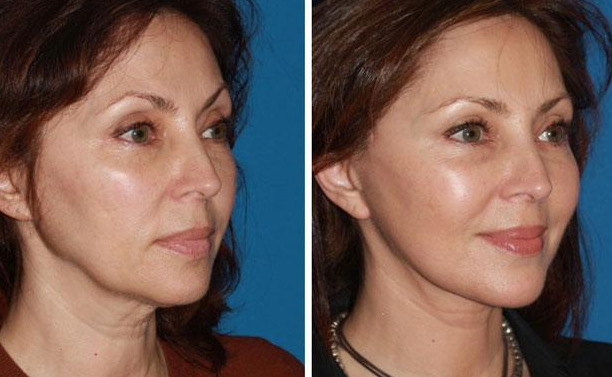When the big 50 rolls in, you may start to notice that physical changes become more and more prominent. Your once-tiny wrinkles may now look deeper, your once-firm skin now sags and loose, and you may feel bothered each time you look in the mirror. If you don’t like what you see in the mirror and you are thinking about getting a cosmetic procedure to get a more youthful appearance, you probably have heard that a facelift is the best cosmetic procedure to have. But, you may wonder “why would I consider a facelift at 50 years of age? Doesn’t a facelift works best on those in their 40s?”
While most people tend to believe that their 40s are the best time to get a facelift, the procedure works wonders on those in their 50s as well. There is actually no ideal age when it comes to the ‘right’ time to have a facelift. Everyone ages differently and facelift is a very personal procedure. At 50, you can still benefit from the numerous benefits that a facelift offer. The procedure will tighten and smooth out your wrinkles, make you feel relaxed, and remove hanging jowls and excess fat. In most cases, you can still enjoy the results of a facelift for 10 years until you need a second facelift.
Want to know more about the benefits of a facelift and why you should consider getting it at 50 years of age? Keep reading!
Is 50 the ideal age for a facelift?
It can be hard to say for sure the exact right age for a facelift. People of the same age may have had different life experiences, genetic traits, and levels of sun exposure that will affect their skin’s condition. While many people tend to say that you should get the procedure before you turn 50 to achieve the best results, this is not necessarily true. Patients between the ages of 40 and 60 are typically ideal to get a facelift because they still have good skin elasticity and are more likely to need a surgical facial rejuvenation. Unlike other non-surgical procedures, a facelift can address more problems associated with aging and give you more dramatic results. Therefore, 50 is still a great age to undergo a facelift.

What makes an ideal candidate for a facelift?
Like many other cosmetic surgeries, a facelift is not for everyone. You need to meet certain requirements to be able to undergo the procedure, which may include:
- Good physical health – it is important that you are generally healthy before you consider a facelift. The procedure is an invasive surgical procedure that requires significant recovery time. As a general rule, the healthier you are, the safer the procedure will be, and the better the results you will get. Therefore, you should not undergo a facelift if you have a medical condition that impairs healing. If in doubt, always talk to your surgeon about any medical condition you have on your initial consultation. Your surgeon will tell you if you can undergo a facelift, or if you should opt for less invasive treatments, such as Dermal Fillers and Botox.
- Overall skin conditions – ideally, your facial skin should still retain some flexibility and elasticity in order for you to achieve the desired results. Lifestyle factors, such as extensive sun damage and smoking, can have a negative impact on the overall success of your facelift. Make sure to discuss these factors with your surgeon before you get a facelift.
- Realistic expectations – while a facelift can set you back a few years younger, it is important that you understand what it can and cannot do. Yes, a successful facelift can give you a youthful appearance and even reduce 10 years off your appearance, but you should always have a realistic expectation about it. With the wrong expectation and attitude, the outcome may only disappoint you. Perfect symmetry, no scarring, and a fantasy look are common unrealistic results that patients want to achieve with their facelift.
- Age-appropriate – As discussed before, there is no perfect age for a facelift. However, a facelift is generally recommended for those between the ages of 40 and 70. Patients older than 70 often have severe skin laxity, which could lead to lower quality facelift results. Those younger than 40 may still be able to get similar results of a facelift from less invasive facial rejuvenation treatments, such as laser skin resurfacing.
What are the best types of facelifts?
There are several types of facelift that people at 50 years of age can consider, these include:
- Mini-Facelift – mini-facelift is a less invasive technique that enables surgeons to tighten deep facial tissues using shorter incisions compared to a traditional facelift. The incisions are typically made along the hairline above the ear or around the natural creases that surround the ear. Through the incisions, the cheeks are tightened and lifted to refine the jawline, correct jows, and rejuvenate the overall appearance. A mini-facelift is often performed under local anesthesia with sedation, but it may also be performed under general anesthesia. A mini-facelift helps you “delay” aging before they become too prominent.
- Upper facelift – sometimes referred to as a brow lift, the upper facelift is suitable for individuals who want to reduce fine lines and wrinkles on their forehead. The procedure is also ideal for those who want to lift the eyebrows so they look more “awake.” During this type of facelift, tiny incisions are created in the hairline in order to lift the skin to the side of the brows. It may also be combined with an eyelid lift to create a more rejuvenated appearance. Mid-facelift – this type of facelift focuses on the nose and cheeks areas. It is often done to reduce deep creases and lines, enhance facial definition and contour, lift sagging cheeks, and tighten the skin. Incisions are created in the hairline and inside the mouth in order to reposition the fat inside the chicks. The mid-facelift is usually done on patients who desire a subtle enhancement.
- Lower facelift – also known as a neck lift, this type of facelift can remove excess fat under the chin and jawline. The removal of fat from those areas will result in a smoother profile and tighter skin, as well as no signs of a double chin.
- Full facelift – the traditional facelift combines the upper, mid, and lower facelift together. It is typically recommended for people with more prominent signs of aging, such as sagging skin, wrinkles, and fine lines. This type of facelift is more popular among older patients, usually those in their late 50s to 60s, who want to restore their youthful features completely. A full facelift is the most invasive procedure of all types of facelifts. However, it will also give the most dramatic results.
How can a facelift benefit people at 50 years of age?
- Get rid of jowls
For some people, jowls can be the most embarrassing facial feature. A facelift can remove them for good, giving you a tighter jawline and slimmer appearance, which will make you look fresh. A skilled surgeon can carefully sculpt your jawline in an artful manner to make it look sharp without a “pulled” appearance or make you look like someone else.
- Redefine your neck
Aging causes the skin in our face to droop, sag, and wrinkle. Most of the time, these changes can make people feel as if they look a lot older than they actually are. Loose skin under the chin and in the neck is one of the most common complaints from people in their 50s. Many people wear turtleneck shirts and high collar shirts to hide these “embarrassing” features. Fortunately, a facelift can easily fix this problem.
- Tighten up sagging skin
After a certain point, all anti-aging creams will not work as well as they should. They will not be able to beat the effects of the sun, volume loss, and time, leaving you with sagging skin. With a facelift, the deep facial and neck muscles will be tightened in order to remove excess skin without looking “pulled.” As a result, you will get a smooth, rested, and youthful appearance without looking like you got anything done.
- Combined with other procedure
Deep lines and wrinkles can make you look tired, particularly when coupled with the loss of volume and tissue structure, making your face appear “worn” and “sunken.” During a facelift, a fat transfer or filler injection can be done to restore the deep tissue structures to their proper position, soften the wrinkles and lines, and restore volume.
- Confidence boost
Since you are going to look younger on the outside, a facelift can also benefit you on the inside. Many people who are not satisfied with the way they look feel unconfident and down because of it. With the more youthful and relaxed appearance that a facelift can give you, you will also feel more youthful and confident. The result will also give you more energy and help you feel like you are ready to face anything coming your way. Many people who have had a facelift said that they are no longer nervous to take advantage of new opportunities or meet new people.

- Look youthful and relaxed naturally
Many people feel apprehensive about getting a facelift because they are afraid that the result will make them look unrecognizable. Some people are also afraid that by getting a facelift, other people will know that they have had work done. If you choose the right surgeon, all of these concerns will not happen. In the hands of an experienced surgeon, a facelift can make you look like a better version of yourself, not a different you. The incisions are going to be made meticulously in your hairline, so scarring is minimal and not noticeable. After a facelift with an experienced surgeon, no one will know that you have had anything done unless you tell them. People will just think that your improved look is the result of adequate rest and a healthy lifestyle.
This is why choosing the right surgeon is important. You should always do background research on your potential surgeon, find their certifications and license, and take a look at the before and after pictures of previous patients. Choosing the right surgeon won’t only give you the best results, but will also eliminate the risks of the surgery.
